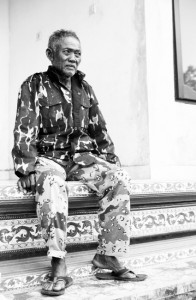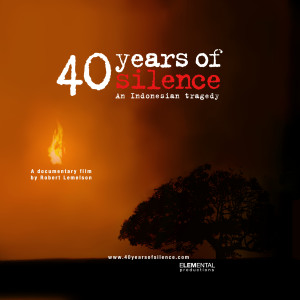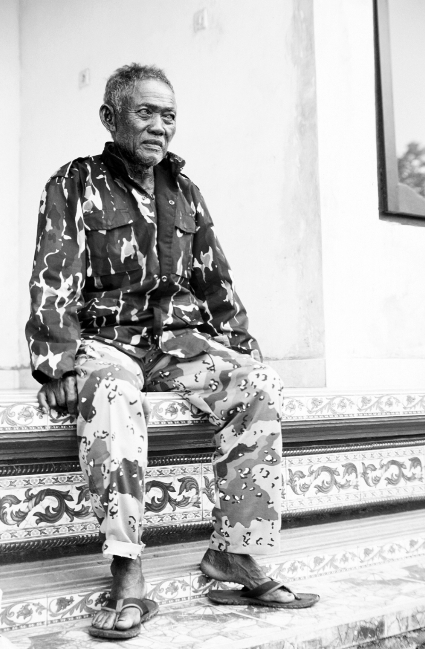
The Act of Killing (2013). A Film by Joshua Oppenheimer.
In the mid 1990s I was conducting transcultural psychiatric research in Bali, Indonesia, exploring the relationship between Balinese culture, individual experience, and the long-term outcome for severe mental illness. Engaging in person-centered ethnography, I interviewed a number of individuals on a weekly or monthly basis throughout the course of a year. I grew quite fond of and became particularly close with to one person, Pak Kereta, a weathered and gentle older man who had a complex relationship with a variety of spirit beings. It was only in our final interview, when I was to return to the States, that Kereta, in hushed and fearful tones, disclosed that in 1965, when “the world turned to chaos,” he had witnessed his father, other family members, and fellow villagers being brutally murdered by paramilitary forces.
A few facts. In 1965, following a purported and historically-contested communist coup attempt (with the complicity, assistance and assent of the CIA), General Suharto led a counter-coup and a campaign against suspected communists that massacred between 500,000-1,000,000 Indonesians in a few short months, largely in North Sumatra, Central Java, East Java and Bali. Under Suharto’s autocratic Orde Baru (New Order) regime, over three decades of enforced silence followed this mass murder. Mention or discussion of the killings was forbidden, and those who challenged the silence were subject to surveillance, arrest, imprisonment and execution.
Before my fieldwork, I was aware of the events of 1965-66. But during these waning years of Suharto’s New Order regime, I quickly discovered that to question any aspect of the official narrative of 1965 was forbidden and dangerous. I myself learned to turn away and submit to this enforced silence. (A few years later I didn’t turn away, and worked on a multi-year research and film project on the victims of the mass killing resulting in the documentary 40 Years of Silence: An Indonesian Tragedy.)
 The Act of Killing, a documentary based on over seven years of shooting in Sumatra, is a film that refuses to look away. It tackles one of the most difficult and contentious subject matters ever filmed—the perceptions of perpetrators of mass violence, who not only were never prosecuted for their crimes, but also are seen by many Indonesians as heroes. The film, in devastating and revealing scenes, documents the moral and conceptual world of perpetrators of mass murder, and, in an original turn, has them reenact these murders on the very killing fields where they occurred. The result is an extraordinarily revealing, original and disturbing creative work.
The Act of Killing, a documentary based on over seven years of shooting in Sumatra, is a film that refuses to look away. It tackles one of the most difficult and contentious subject matters ever filmed—the perceptions of perpetrators of mass violence, who not only were never prosecuted for their crimes, but also are seen by many Indonesians as heroes. The film, in devastating and revealing scenes, documents the moral and conceptual world of perpetrators of mass murder, and, in an original turn, has them reenact these murders on the very killing fields where they occurred. The result is an extraordinarily revealing, original and disturbing creative work.
There are few projects that deal so directly with perpetrators: Alex Hinton’s work with Khmer Rouge cadres comes to mind, as does Robert Jay Lifton’s work with Nazi doctors. But neither are visual representations, which bring an emotional immediacy and richness that is difficult to capture in written word.
As a filmmaker, I have great respect for Joshua Oppenheimer’s method. To befriend, film, and track a community for years is a daunting feat. To do so with such people as Anwar Congo and Herman Koto—the chief protagonists who describe their brutal acts in stunning detail and an offhand, almost gleeful manner—almost defies belief. Oppenheimer does this with compassion and honesty, after having spent years exploring the domain of perpetrators in extraordinary depth. Indeed, he has stated that the film’s central character, Anwar Congo, was the 43rd perpetrator he interviewed. This form of fieldwork would be the envy of most anthropologists. Few in our profession can devote the amount of time, effort and resources required to accomplish this, and fewer still can do it with the sense of aesthetics that mark The Act of Killing.
Another interesting aspect of the film is the moral worlds in which the protagonists (read: killers, as they were referred to by my interviewees) live. Some in the film are aware that what they were doing could be judged as war crimes or crimes against humanity. They more or less argue that in war the victors define the meaning of “war crimes”, and since they “won” the conflict against the Indonesian Communist Party, they can create their own definitions of war crimes. While this seems a perversion of international justice and law, this moral equivalence argument is similar one put forth by Robert McNamara in Errol Morris’ (an EP on “The Act of Killing”) film The Fog of War. McNamara describes how aerial bombardment of Japan in World War II would appear if Japan had won the war—both he and Leslie Groves would be convicted as war criminals.
Others, like Congo himself, seem largely unaware of these global discourses on justice, and appear to have entirely accepted the models put forward by the New Order regime. Indeed, in my interviews with perpetrators, much of the reasoning in The Act of Killing rings true. My interviewees essentially argued that there was a war in 1965, people are killed in war, that they were doing their duty as patriots, and should be (and generally were) regarded as heroes in their local communities. These were men who killed their fellow villagers, often with great cruelty, in extrajudicial executions.

While watching The Act of Killing I was surprised that I still had several epiphanies, even though I had worked on similar material and subject matter. While I had interviewed perpetrators during the course of my research and film, I consciously decided not to focus on their motivations or development as characters in their own right. Due to this turning away, I missed key factors of life for many Indonesians, including the sense of caution/fear that pervades many areas of the social world. The film documents how preman (gangsters) operate throughout Indonesia, dealing in extortion, graft, and other coercive, criminal enterprises. The film further explores the ubiquitous nature of both low and high-level criminality: several of the characters shakedown Chinese shopkeepers in a crowded market while others brag about threatening entire neighborhoods to allow new real estate development, the demolition of their homes, and profiting from the pittance given in recompense to these communities.
While I was aware of the pervasive nature of collusion, corruption and nepotism that existed under the New Order, and continues to this day in many ways, I had not directly encountered this in my fieldwork, except in the occasional shakedowns for uang rokok (cigarette money) by local traffic police. Viewing the shakedown of the Chinese shop owners was a revelation for me, and caused me to rethink the conditions of power, control and authority under which the lives of some of my interviewees are determined.
I personally had a problem with the ending of the film. After playing a victim in a reenactment of one of his killings, Anwar Congo begins to awaken to the horrors he inflicted on so many. His purported change of heart emblematized by an embodied reaction of attempting to vomit, is difficult to watch. The process by which Anwar arrives at these moral qualms is skillfully portrayed—but is the glimmerings of remorse by an admitted mass murderer something that really deserves our attention, let alone sympathy? When I met Oppenheimer for lunch several months ago, he mentioned he was working on another film, this time from the perspective of the victims. I greatly look forward to such a film, as it would balance the portrayal of perpetrators with those who suffered great violence and loss at their hands.
Another problematic aspect of the film, and one that is not the responsibility of the filmmaker, is the portrayal of Indonesian society. For the majority of American viewers, The Act of Killing will be one of their only exposures to a detailed look at Indonesian society not mediated by the culturally-commoditized imagery of dancer, batik and gamelan put forward by the New Order regime (see the recent work by Diyah Larasati on this issue). The view of Indonesia put forth in The Act of Killing is almost entirely negative—a viewer could walk away with a sense that all Indonesian social life is corrupt, coercive, and violent on all levels, that the sense of aesthetics was predominantly kitsch, and that the population subjected to this are largely passive and victimized. While much of these rings true, there have been many internal efforts in the past decade to address the mass violence of 1965 and its aftermath, including lectures, artistic productions, and community-level reconciliation projects. In a recent lecture, Father Baskara Wardaya, a prominent historian of the post-New Order period, listed scores of such events, projects, and programs that comprise this endeavor.

What hasn’t happened, however, is a national project of truth and reconciliation. There are many things that the government can do, such as creating a legal framework for a Truth and Reconciliation Commission (TRC) that would confront the 1965 killings and related human rights violations. The government can also make greater efforts for rehabilitate those who have been wrongly imprisoned, tortured or socially stigmatized. On a broader scale, the government could help launch educational, memorial and remembrance projects like those in other countries that have experienced mass killings and genocide (e.g.: Germany, Bosnia, Cambodia, etc.). This would involve having open discussions about the event, exhumations of the thousands of unmarked mass graves that cover the Indonesian landscape, forensic identifications of victims, and broader/longer-lasting memorials and museums. Indonesia’s government in general seems a long way off from engaging in this, but any effort is a positive step forward.
The Act of Killing should be seen by all anthropologists with an interest in genocide, violence, state power/terror, and the scholarly, judicial and activist issues that intersect this difficult but important area of inquiry. I eagerly look forward to future pieces on this and related subjects by Mr. Oppenheimer. He has much to teach, and a body of disturbing and profound material to support this.
Robert Lemelson is a cultural anthropologist and ethnographic filmmaker. Lemelson’s area of specialty is transcultural psychiatry; Southeast Asian Studies, particularly Indonesia; and visual, psychological and medical anthropology. He currently is a research anthropologist in the Semel Institute of Neuroscience UCLA, and an adjunct professor of Anthropology at UCLA. Lemelson founded Elemental Productions, a documentary production company, and has directed and produced numerous ethnographic films on diverse topics as social and state violence, mental illness, ritual life, trance and possession, the sex trade, and polygamy.



2 Responses
For me the ending of this film was a stroke of genius, not “a problem” as this reviewer suggests. In exploring the dream worlds of state-sanctioned murderers, “The Act of Killing” gives a presence to hauntings. Watching Anwar Congo retch did not make me feel any sympathy for him. This final scene instead invoked the agency of the dead. Ghosts from this 20th century genocide continue to disturb contemporary Indonesia. Documentary films about genocide, which deploy a stick-to-the-facts approach, risk losing audiences in the horrific details. Oppenheimer remains true to the facts while capturing our imagination with strange characters who inhabit macabre fantasies.
After Japan’s wartime occupation ended, independence was proclaimed in 1945 by Sukarno,Michael Kors, the independence movement’s leader.